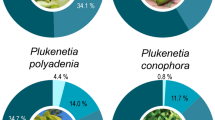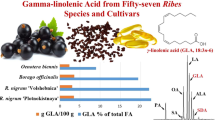Abstract
The seed fatty acid (FA) compositions of Abietoids (Abies, Cedrus, Hesperopeuce, Keteleeria, Pseudolarix, and Tsuga) are reviewed in the present study in conclusion to our survey of Pinaceae seed FA compositions. Many unpublished data are given. Abietoids and Pinoids (Pinus, Larix, Ficea, and Pseudotsuga)—constituting the family Pinaceae—are united by the presence of several Δ5-olefinic acids, taxoleic (5,9–18∶2), pinolenic (5,9,12–18∶3) coniferonic (5,9,12,15–18∶4), keteleeronic (5,11–20∶2), and sciadonic (5,11,14–20∶3) acids, and of 14-methyl hexadecanoic (anteiso-17∶0) acid. These acids seldom occur in angiosperm seeds. The proportions of individual Δ5-olefinic acids, however, differ between Pinoids and Abietoids. In the first group, pinolenic acid is much greater than taxoleic acid, whereas in the second group, pinolenic acid is greater than or equal to taxoleic acid. Moreover, taxoleic acid in Abietoids is much greater than taxoleic acid in Pinoids, an apparent limit between the two subfamilies being about 4.5% of that acid relative to total FA. Tsuga spp. appear to be a major exception, as their seed FA compositions are much like those of species from the Pinoid group. In this respect, Hesperopeuce mertensiana, also known as Tsuga mertensiana, has little in common with Abietoids and fits the general FA pattern of Pinoids well. Tsuga spp. and H. mertensiana, from their seed FA compositions, should perhaps be separated from the Abietoid group and their taxonomic position revised. It is suggested that a “Tsugoid” subfamily be created, with seed FA in compliance with the Pinoid pattern and other botanical and immunological criteria of the Abietoid type. All Pinaceae genera, with the exception of Pinus, are quite homogeneous when considering their overall seed FA compositions, including Δ5-olefinic acids. In all cases but one (Pinus), variations from one species to another inside a given genus are of small amplitude. Pinus spp., on the other hand, have highly variable levels of Δ5-olefinic acids in their FA compositions, particularly when sections (e.g., Cembroides vs. Pinus sections) or subsections (e.g., Flexiles and Cembrae subsections from the section Strobus) are compared, although they show qualitatively the same FA patterns characteristic of Pinoids. Multicomponent analysis of Abietoid seed FA allowed grouping of individual species into genera that coincide with the same genera otherwise characterized by more classical botanical criteria. Our studies exemplify how seed FA compositions, particularly owing to the presence of Δ5-olefinic acids, may be useful in sustaining and adding some precision to existing taxonomy of the major family of gymnosperms, Pinaceae.
Similar content being viewed by others
Abbreviations
- anteiso-17∶0:
-
14-methylhexadecanoic
- FA:
-
fatty acid
- FAME:
-
fatty acid methyl esters
- GLC:
-
gas-liquid chromatography
- UPIFA:
-
unsaturated polymethylene-interrupted fatty acid
References
Page, C.N. (1990) Gymnosperms: Coniferophytina (Conifers and Ginkgoids, in The Families and Genera of Vascular Plants (Kubitski, K., ed.), Vol. 1, Pteridophytes and Gymnosperms (Kramer, K.U., and Green, P.S., eds.), pp. 319–329, Springer-Verlag, Berlin.
Wolff, R.L., Pédrono, F., Pasquier, E., and Marpeau, A.M. (2000) General Characteristics of Pinus spp. Seed Fatty Acid Compositions, and Importance of Δ5-Olefinic Acids in the Phylogeny and Taxonomy of the Genus, Lipids 35, 1–22.
Wolff, R.L., Lavialle, O., Pédrono, F., Pasquier, E., Deluc, L.G., Marpear, A.M., and Aitzetmüller, K. (2001) Fatty Acid Compositions of Pinaceae as Taxonomic Markers, Lipids 36, 439–451.
Wolff, R.L., Deluc, L.G., Marpeau, A.M., and Comps, B. (1997) Chemotaxonomic Differentiation of Conifer Families and Genera Based on the Seed Oil Fatty Acids Compositions: Multivariate Analyses, Trees 12, 57–65.
Wolff, R.L., Comps, B., Deluc, L.G., and Marpeau, A.M. (1997) Fatty Acids of the Seeds from Pine Species of the Ponderosa-Banksiana and Helepensis Sections. The Peculiar Taxonomic Position of Pinus pinaster, J. Am. Oil. Chem. Soc. 74, 45–50.
Wolff, R.L., Comps, B., Marpeau, A.M., and Deluc, L.G. (1997) Taxonomy of Pinus Species Based on the Seed Oil Fatty Acid Compositions, Trees 12, 113–118.
Wolff, R.L. (1998) Clarification on the Taxonomic Position of Sciadopitys verticillata Among Coniferophytes Based on Seed Oil Fatty Acid Compositions, J. Am. Oil Chem. Soc. 75, 757–758.
Price, R.A., Olsen-Stojkovich, J., and Lowenstein, J.M. (1987) Relationships Among the Genera of Pinaceae: An Immunological Comparison, Syst. Bot. 12, 91–97.
Frankis, M.P. (1988) Generic Inter-relationships in Pinaceae, Notes RBG Edinb. 45, 527–548.
Li, L.C. (1995) Studies on the Karyotype and Phylogeny of the Pinaceae, Acta Phytotax. Sin. (Zhiwu Fenlei Xuebao) 33, 417–432 (in Chinese; summary in English and descriptions in Latin).
Wolff, R.L., Christie, W.W., Pédrono, F., Marpeau, A.M. Tsevegsüren, N., Aitzetmüller, K., and Gunstone, F.D. (1999) Δ5-Olefinic Acids in the Seed Lipids from Four Ephedra Species and Their Distribution Between the α and β Positions of Triacylglycerols. Characteristics Common to Coniferophytes and Cycadophytes, Lipids 34, 855–864.
Wolff, R.L. (1999) The Phylogenetic Significance of Sciadonic (all-cis-5,11,14–20∶3) Acid in Gymnosperms and Its Quantitative Significance in Land Plants, J. Am. Oil. Chem. Soc. 76, 1515–1516.
Ekman, R. (1980) New Polyenoic Fatty Acids in Norway Spruce Wood, Phytochemistry 19, 147–148.
Jamieson, G.R., and Reid, E.H., (1972) The Leaf Lipids of Some Conifer Species, Phytochemistry 11, 269–275.
Berdeaux, O., and Wolff, R.L. (1996) Gas-Liquid Chromatography-Mass Spectrometry of the 4,4-Dimethyloxazoline Derivatives of Δ5-Unsaturated Polymethylene-Interrupted Fatty Acid from Conifer Seed Oils, J. Am. Oil Chem. Soc. 73, 1323–1326.
Wolff, R.L. (1998) A Practicval Source of Δ5-Olefinic Acids for Identification Purposes, J. Am. Oil Chem. Soc. 75, 891–892.
Tsevegsüren, N., and Aitzetmüller, K. (1997) Unusual Δ5cis-FA in Seed Oils of Cimicifuga Species, J. High Resolut. Chromatogr. 20, 237–241.
Wolff, R.L., Deluc, L.G., and Marpeau, A.M. (1996) Conifer Seeds: Oil Content and Fatty Acid Distribution, J. Am. Oil. Chem. Soc. 73, 765–771.
Kovac, M., and Vardjan, M. (1981) Metabolism of Lipids in Fir Seeds (Abies alba Mill.). Acta Bot. Croat. 40, 95–109.
Rutar, V., Kovac, M., and Lahajna, V. (1989) Nondestructive Study of Liquids in Single Fir Seeds Using Nuclear Magnetic Resonance and Magic Angle Sample Spinning, J. Am. Oil Chem. Soc. 66, 961–965.
Takagi, T., and Itabashi, Y. (1982) cis-5 Olefinic Unusual Fatty Acid in Seed Lipids of Gymnospermae and Their Distribution in Tricylglycerols, Lipids 17, 716–723.
Farjon, A., and Rushforth, K.D. (1989) A Classification of Abies Miller (Pinaceae), Notes RBG Edinb. 46, 59–79.
Debazac, E.B. (1964) Manuel des Conifères, Ecole Nationale des Eaux et Forêts, Nancy, pp. 49–78 (in French).
Wolff, R.L., Pédrono, F., Marpeau, A.M., Christie, W.W., and Gunstone, F.D. (1998) The Seed Fatty Acid Composition and the Distribution of Δ5-Olefinic Acids in the Triacyglycerols of Some Taxaceae (Taxus and Torreya), J. Am. Oil Chem. Soc. 75, 1637–1641.
Farjon, A. (1998) World Checklist and Bibliography of Conifers, pp. 137–237. The Royal Botanic Gardens, Kew, United Kingdom.
Taylor, R.J. (1972) The Relationship and Origin of Tsuga heterophylla and Tsuga mertensiana Based on Phytochemical and Morphological Interpretations, Am. J. Bot. 59, 149–157.
Wolff, R.L., Destaillats, F., and Angers, P. (2001) α-Linolenic Acid and Its Δ5-Desaturation Product, Coniferonic Acid, in the Seeds of Tsuga and Hesperopeuce as a Taxonomic Means to Differentiate the Two Genera, Lipids 36, 211–212.
Farjon, A. (1990) Pinaceae: Drawings and Descriptions of the Genera Abies, Cedrus, Pseudolarix, Keteleeria, Nothotsuga, Tsuga, Cathya, Pseudotsuga, Larix and Picea Regnum Veg. 121, 111–121.
Farjon, A. (1989) A Second Revision of the Keteleeria Carrière (Taxonomic Notes on Pinaceae II), Notes RBG Edinb., 46, 81–99.
Folch, J., Lees, M., and Sloane-Stanley, G.H. (1957) A Simple Method for the Isolation and Purification of Total Lipids [sic] from Animal Tissues, J. Biol. Chem., 226, 497–509.
Prager, E.M., Fowler, D.P., and Wilson, A.C. (1976) Rates of Evolution in Confifers (Pinaceae), Evolution, 30, 637–649.
Author information
Authors and Affiliations
Corresponding author
About this article
Cite this article
Wolff, R.L., Lavialle, O., Pédrono, F. et al. Abietoid seed fatty acid composition—A review of the genera Abies, Cedrus, Hesperopeuce, Keteleeria, Pseudolarix, and Tsuga and preliminary inferences on the taxonomy of Pinaceae. Lipids 37, 17–26 (2002). https://doi.org/10.1007/s11745-002-0859-5
Received:
Revised:
Accepted:
Issue Date:
DOI: https://doi.org/10.1007/s11745-002-0859-5




